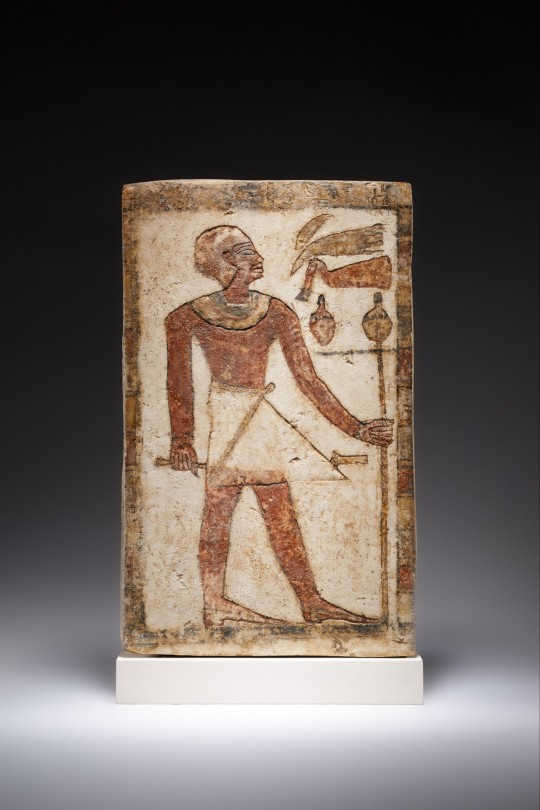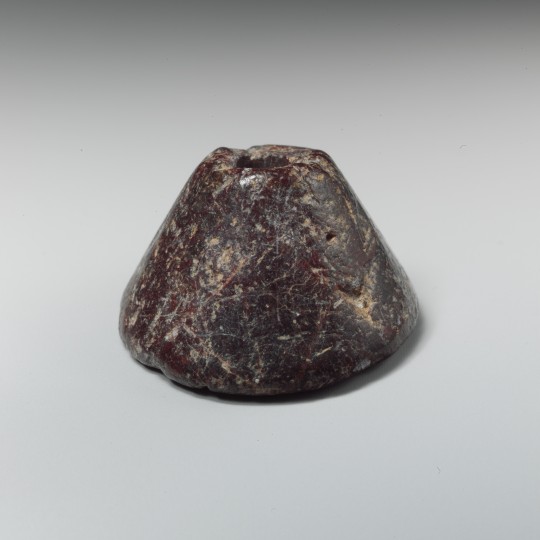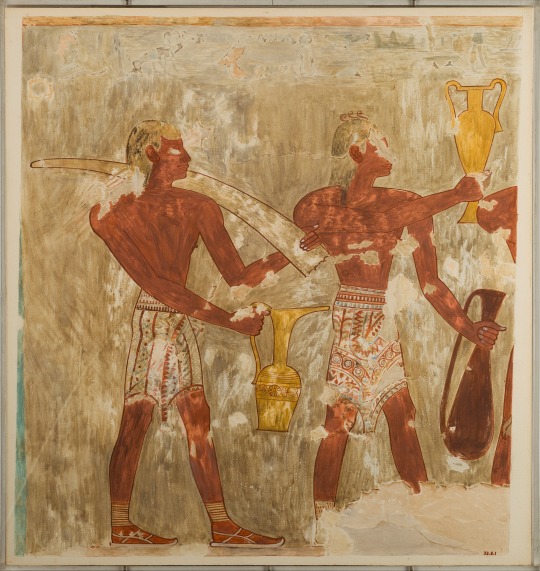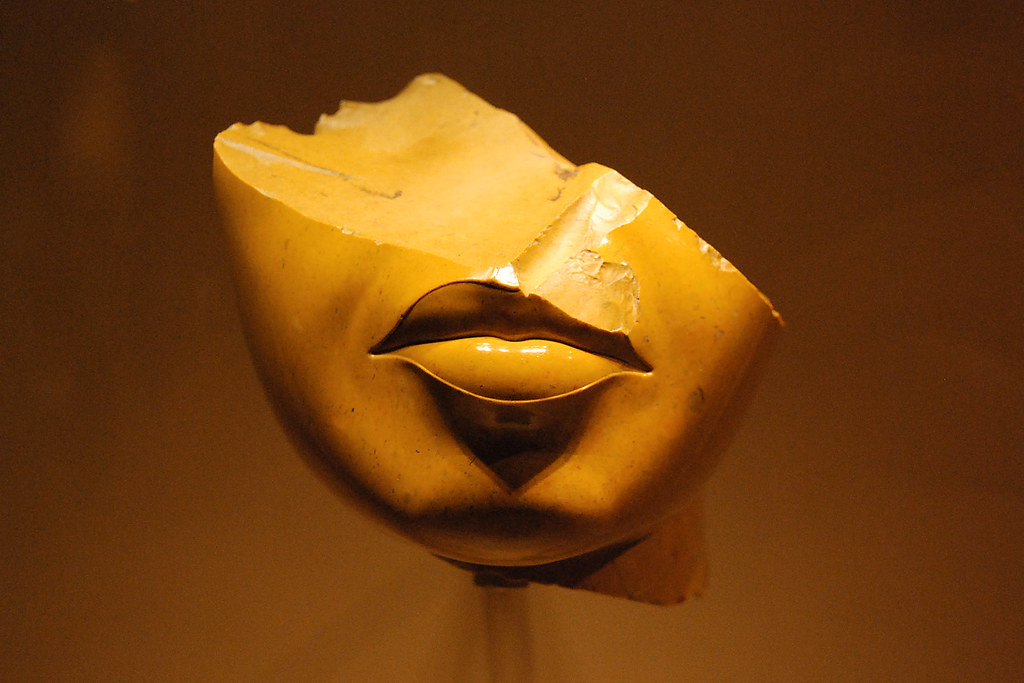#ca. 1926 b.c.
Text

~ Stela of a Man.
Period: Middle Kingdom, 11th Dynasty
Date: ca. 2030–1981 B.C.
Place oforigin: Egypt, Upper Egypt, Thebes, Deir el-Bahri, Cemetery 100, Tomb TT 114, MMA excavations, 1926–27
Medium: Limestone, paint
#ancient#ancient art#history#museum#archeology#ancient egypt#ancient sculpture#ancient history#archaeology#egyptian#egyptology#Egypt#stela of a man#11th Dynasty#middle kingdom#thebes#ca. 2030 b.c.#ca. 1981 b.c.
604 notes
·
View notes
Text

A Barber at Work and Men Waiting Their Turn - Met Museum Collection
Note: This is a modern copy of an original
Inventory Number: 30.4.40
Original Dating: New Kingdom, Dynasty 18, ca. 1427–1400 B.C.
Location Information: From Egypt, Upper Egypt, Thebes
Description:
This facsimile painting copies part of a scene in the tomb of Userhat (TT 56) at Thebes. This vignette depicts men waiting their turn to have their hair cut by the barber who is at work in the lower left. The facsimile was painted at the tomb in 1925-1926 by Nina deGaris Davis who was a member of the Graphic Section of the Museum's Egyptian Expedition.
#A Barber at Work and Men Waiting Their Turn#new kingdom#new kingdom pr#dynasty 18#upper egypt#thebes#met museum#30.4.40#tomb of userhat#mens hair and wigs#NKPRMHW
0 notes
Text
Stone Mason's Chisel
Period: Middle Kingdom
Dynasty: Dynasty 11
Reign: reign of Mentuhotep II
Date: ca. 2051–2000 B.C.
Geography: From Egypt, Upper Egypt, Thebes, Deir el-Bahri, Tomb MMA 101, in front of chamber 3 west, MMA excavations, 1926–27
Medium: Hammered bronze or copper alloy
This chisel was clearly made for use and looks as if it has indeed been used. It was found in a tomb that contained at least six burials but no object of demonstrably post-Mentuhotep II date. There was even a piece of linen marked for Mentuhotep II's wife Queen Neferu. The mark incised into the chisel was previously understood to represent the pyramid which Museum excavator Herbert E. Winlock and others thought had originally existed above the solid core structure of the temple of Mentuhotep II at Deir el-Bahri. The existence of this pyramid has been put into doubt, however, although renewed discussions are under way. The mark also occurs on linen sheets from the tomb of the "Slain Soldiers" (MMA 507 see here 27.3.84-134), which has been shown to be of the time of Senwosret I, and on another piece of linen found at Lisht South close to the pyramid of that king. The sign can, therefore, no longer be exclusively associated with the temple of Mentuhotep II at Deir el-Bahri, even if this particular chisel was made and used during that king's reign. The mark's form and purpose remain enigmatic.



1 note
·
View note
Photo

Stone spindle whorl. ca. 2400–1900 B.C.. Credit line: Bequest of Richard B. Seager, 1926 https://www.metmuseum.org/art/collection/search/252326
#aesthetic#art#abstract art#art museum#art history#The Metropolitan Museum of Art#museum#museum photography#museum aesthetic#dark academia
0 notes
Photo

Sphinx of Hatshepsut (ca. 1479–1458 B.C.) | New Kingdom The reconstructed sections of this sphinx 𓎛𓅱𓃭𓏤 “hw” or 𓊏𓊪𓃭 “šsp” have been cast from an almost identical, but more complete companion piece now in Cairo. The two small limestone 𓇋𓈖𓂋𓊌𓈖𓂝𓈖𓁼𓊌 “inr-n-ˁı͗nw” sphinxes may have been on either side of the entrance to the upper terrace of Hatshepsut’s mortuary temple at Deir el-Bahri 𓉞𓉐𓁨 “ḥw.t-ḥˁḥ“ Temple of Millions of Years”. The head of this sphinx differs markedly from Hatshepsut’s (𓇋𓏠𓈖𓎸𓏏𓄂𓏏𓀼𓏪) “imn-ẖnmt ḥA.t-šps.wt” ‘United with Amun, Foremost of Nobel Ladies’ large sphinxes in which the human head 𓁷𓏤 “ḥr” wears the royal nemes-headcloth 𓌰𓅓𓋴𓌆 “nms”. Instead, this example was fashioned according to a type of sphinx bet known from the Middle Kingdom during the reign of Amenemhat III (ca. 1859-1813 B.C.). In this sphinx, the only human element is the face which is surrounded by a lion's 𓃭 “rw” mane. Remains of pigment show that the face was painted yellow 𓏘𓈖𓇋𓏏𓏬 “qni.wt”, the color used for women in Egyptian Art. Dynasty: Dynasty 18 Reign: Joint reign of Hatshepsut and Thutmose III Geography: From Egypt, Upper Egypt, Thebes, Deir el-Bahri, Senenmut Quarry, MMA excavations, 1926–28 Medium: Limestone, plaster Dimensions: L. 106.7 × W. 33 × H. 63.5 cm, 196 kg (42 × 13 × 25 in., 432 lb.); H. (of base): 18 cm (7 1/16 in.) 𓋹𓎬𓋹𓎬𓋹𓎬𓋹𓎬𓋹𓎬𓋹𓎬𓋹𓎬𓋹𓎬𓋹𓎬𓋹𓎬𓋹𓎬𓋹𓎬𓋹𓎬𓋹𓎬𓋹𓎬𓋹𓎬 📸 and 🎥 @egyptologylessons 𓋹𓊽𓋴𓆖𓎛𓇳𓎛 © (@metmuseum and description) 𓊁𓊁𓊁𓊁𓊁𓊁𓊁𓊁𓊁𓊁𓊁𓊁𓊁𓊁𓊁𓊁𓊁 #Ancientegypt #ägypten #egyptianhistory #egyptology #hieroglyphs #egypte #egitto #埃及 #مصر #egipto #이집트 #hatshepsut #sphinx #metropolitanmuseumofart #statue https://www.instagram.com/p/CcvInzhOdDK/?igshid=NGJjMDIxMWI=
#ancientegypt#ägypten#egyptianhistory#egyptology#hieroglyphs#egypte#egitto#埃及#مصر#egipto#이집트#hatshepsut#sphinx#metropolitanmuseumofart#statue
25 notes
·
View notes
Text

Barbering, Tomb of Userhat
A.D. 1922; original ca. 1427–1400 B.C.
Twentieth Century; original New Kingdom
Nina de Garis Davies
On view at The Met Fifth Avenue in Gallery 135
This facsimile painting copies part of a scene in the tomb of Userhat (TT 56) at Thebes. This vignette depicts men waiting their turn to have their hair cut by the barber who is at work in the lower left. The facsimile was painted at the tomb in 1925-1926 by Nina deGaris Davis who was a member of the Graphic Section of the Museum's Egyptian Expedition.
Object Details
Title: Barbering, Tomb of Userhat
Artist: Nina de Garis Davies (1881–1965)
Period: Twentieth Century; original New Kingdom
Dynasty: Dynasty 18
Reign: reign of Amenhotep II
Date: A.D. 1922; original ca. 1427–1400 B.C.
Geography: From Egypt, Upper Egypt, Thebes
Medium: Tempera on paper
Dimensions: facsimile: h. 45 cm (17 11/16 in); w. 73 cm (28 3/4 in)
scale 1:1
framed: h. 48.6 cm (19 1/8 in); w. 76.2 cm (30 in)
Credit Line: Rogers Fund, 1930
Accession Number: 30.4.40
19 notes
·
View notes
Photo

Fragment of a funerary relief with an offering scene
Middle Kingdom (12th Dynasty, probably reign of Senwosret I)
Egyptian, ca. 1971–ca. 1926 B.C.
Painted limestone
Princeton University Art Museum
22 notes
·
View notes
Photo

Title: Relief of an Acacia Tree Shading Water Jars with Drinking Cups
Metropolitan Museum of Art
Period: Middle Kingdom
Dynasty: Dynasty 11
Reign: reign of Mentuhotep II, early
Date: ca. 2051–2030 B.C.
Geography: From Egypt, Upper Egypt, Thebes, Deir el-Bahri, Tomb of Neferu (TT 319, MMA 31), MMA excavations, 1923–25
Medium: Limestone, paint
Dimensions: H. 83 x W. 88.5 cm (32 11/16 x 34 13/16 in.)
Credit Line: Rogers Fund, 1926
Accession Number: 26.3.353c
This period in Egyptian history is known for great cultural change in Egyptian society, including the ideology of kingship, the organization of society, religious practices, afterlife beliefs, and relations with neighboring peoples. Such changes can be seen in this relief, which features water jars beneath an acacia tree, there may be hidden allusions to beliefs about the afterlife. In the Old Kingdom, an institution called “the acacia house” was maintained at the solar cult site of Heliopolis, which is near present day Cairo. A group of women who belonged to the acacia house served as mourners and ritual dancers at each pharaoh’s funeral. It is suggested that Queen Neferu may have been a member of Mentuhotep II’s acacia house.
1 note
·
View note
Text
Here's Why Many Egyptian Statues Have Broken Noses
Here’s Why Many Egyptian Statues Have Broken Noses

Face of Senwosret III, ca. 1878–1840 B.C. Egyptian, Middle Kingdom Red quartzite; h. 16.5 cm (6 1/2 in) The Metropolitan Museum of Art, New York, Purchase, Edward S. Harkness Gift, 1926 (26.7.1394) http://www.metmuseum.org/Collections/search-the-collections/544184
“The consistency of the patterns where damage is found in sculpture suggests that it’s purposeful,” Bleiberg said, citing myriad…
View On WordPress
0 notes
Photo

Head from the Statuette of a King ca. 1479–1458 B.C. New Kingdom Met Museum, New York Object Details Title:Head from the Statuette of a King Period:New Kingdom Dynasty:Dynasty 18 Date:ca. 1479–1458 B.C. Geography:From Egypt Medium:Basalt Dimensions:h. 5 cm (1 15/16 in) Credit Line:Purchase, Edward S. Harkness Gift, 1926 Accession Number:26.7.1400 #ancient #egyptian #history #museum https://www.instagram.com/p/CDOf4QiHJ9o/?igshid=1t3yphapnapeo
0 notes
Text


~ Statue of Lady Sennuwy.
Period: Middle Kingdom, 12th Dynasty, reign of Senusret I
Date: ca. 1971-1926 B.C.
Place of origin: Lower Nubia (Sudan), Kerma, Tumulus K III.
Medium: Granodiorite
#ancient#ancient art#history#museum#archeology#ancient egypt#ancient sculpture#archaeology#ancient history#egyptian#egyptology#egypt#statue of lady sennuwy#middle kingdom#12th Dynasty#senusret i#nubia#sudan#kerma#granodiorite#ca. 1971 b.c.#ca. 1926 b.c.
519 notes
·
View notes
Text

Aegean Islanders in the Tomb of Rekhmire - Met Museum Collection
Note: This is a modern copy of an original
Inventory Number: 33.8.1
Original Dating: New Kingdom, Dynasty 18, ca. 1479–1400 B.C.
Location Information: Original from Egypt, Upper Egypt, Thebes, Sheikh Abd el-Qurna, Tomb of Rekhmire (TT 100), MMA graphic expedition, 1926
#Aegean Islanders in the Tomb of Rekhmire#Tomb of Rekhmire#new kingdom#new kingdom pr#dynasty 18#upper egypt#thebes#sheikh abd el-qurna#sheikh abd el qurna#met museum#33.8.1#foreigners#NKPRForeigners
0 notes
Photo

Scarab Inscribed "Hatshepsut, United with Amun"ca. 1479–1458 B.C. New Kingdom During the 1926-1927 excavation season, the Museum's Egyptian Expedition uncovered three foundation deposits along the eastern enclosure wall of Hatshepsut's funerary temple at Deir el-Bahri in Western Thebes. Among the contents were 299 scarabs and stamp-seals. Sixty-five of these are now in the Egyptian Museum, Cairo, and the rest were acquired by the Museum in the division of finds. Among the inscriptions on the bases of these scarabs and seals are examples of every title Hatshepsut held, from the time she was "king's daughter" during the reign of her father, Thutmose I; through the time she was queen of her half-brother, Thutmose II; and during her co-reign with her nephew/step-son, Thutmose III. Thirteen of the scarabs (27.3.199 to 27.3.212) are inscribed with various writings of the extended form of Hatshepsuts personal name, Hatshepsut-united-with-Amun, which sometimes appears, enclosed in a cartouche, as the last element of her titulary as king. By adopting this name, Hatshepsut links herself to the powerful god Amun of Thebes, whom she claimed as her father. This example is the largest and most elaborately carved of the scarabs. Unlike others, the body of the beetle has been partially separated from the base. A triangular repair is also visible in the upper right of the base, and a small ankh hieroglyph (life) may be seen in the lower right. Dynasty:Dynasty 18 Reign:Joint reign of Hatshepsut and Thutmose III Date:ca. 1479–1458 B.C. Geography:From Egypt, Upper Egypt, Thebes, Deir el-Bahri, Temple of Hatshepsut, Foundation Deposit 7 (G), MMA excavations, 1926–27 Medium:Steatite (glazed) Dimensions:L. 2 cm (13/16 in); w. 1.5 cm (9/16 in); h. 0.8 cm (5/16 in) #Tutankhamun. #BritishMuseum #egyptianmuseum #MuseumFromHome #bkmegyptianart #ancientring #Egypt #AncientEgyptian #JewelryAncientEgyptian #Jewelleryancientegyptian #ringsancientegyptian #scarabsrings #scarabs #newkingdom #jewellerybloger #instajewelry #egyptological #egyptianjewelry #tutankhamón #18Dynasty #newkingdom #metmuseum (at The Metropolitan Museum of Art, New York) https://www.instagram.com/p/CCG6679Bsrp/?igshid=1xd8w9036mmxj
#tutankhamun#britishmuseum#egyptianmuseum#museumfromhome#bkmegyptianart#ancientring#egypt#ancientegyptian#jewelryancientegyptian#jewelleryancientegyptian#ringsancientegyptian#scarabsrings#scarabs#newkingdom#jewellerybloger#instajewelry#egyptological#egyptianjewelry#tutankhamón#18dynasty#metmuseum
0 notes
Video
Fragment of the Face of a Queen, Head, Queen Tiye (?), ca. 1353–1336 B.C by Molly
Via Flickr:
Fragment of the Face of a Queen, Head, Queen Tiye (?), ca. 1353–1336 B.C.; New Kingdom, Amarna Period Egyptian; Amarna possibly; Middle Egypt Yellow jasper; H. 13 cm (5 1/8 in); w. 12.5 cm (4 15/16 in); d. 12.5 cm (4 15/16 in) Purchase, Edward S. Harkness Gift, 1926 (26.7.1396) This extraordinary fragment, polished to a mirrorlike finish, probably belonged to a composite statue in which only the exposed parts of the body were made of jasper. In Egyptian artistic convention, the color yellow usually indicates a woman, and the scale and superb quality of the work implies that it represents a queen. The back of the piece shows remains of the mortise that fitted into a tenon extending from the statue's body, which may have been made of Egyptian alabaster to represent a white garment. Two headdresses might have fit this head, one of which is the so-called Nubian wig (like the one on a canopic jar lid in the Museum, Highlight #30), often worn by the women of Akhenaten's family. The royal woman represented here cannot be securely identified. It is difficult to imagine that Akhenaten's already aged mother, Queen Tiye—highly respected as a wise woman at Amarna—was shown as a beauty of such sensuous character. His principal queen, Nefertiti, and his secondary queen, Kiya, however, are both possible subjects.
2 notes
·
View notes
Photo

Fragment of a Queen's Face Although this piece only survives as a fragment, its rare stone material and exquisite workmanship indicate this woman 𓊃𓏏𓁐 “s.t” could only represent an important queen 𓇓𓈞𓏏 “ḥm.t-n(y)-sw”. The enigmatic mouth 𓂋𓏤 “r” has intrigued scholars as they consider her identity and how the lips' mirror-like surface was achieved some 3,300 𓆾𓍤 years 𓆳𓊪𓏏𓏤 “rnp.t” ago. The face 𓁷𓏤 “ḥr” was part of a composite statue 𓂙𓏏𓏭𓀾 “ḫnty”, that is, a work whose parts were made from different materials fitted together to create 𓈎𓌳𓄿𓅓𓌙𓏛 “qm3” the sculpture. Her face, hands, and feet 𓂋𓂧𓂾𓂾 “rd.wy” most likely were in yellow jasper, but her clothing was probably in limestone 𓇋𓈖𓂋𓊌𓈖𓂝𓈖𓁼𓊌 “ı͗nr-n-ˁı͗nw” and her crown in yet another medium. The face's color and reflective surface implied the owner's connection to the sun 𓇳 “rˁ” especially relevant as the work dates to a time 𓊃𓊪𓊗 “sp” in which the king 𓇓𓏏𓈖 “nsw” vigorously promoted the sun's worship 𓇼𓄿𓀃 “dw3”. From Egypt (acquired from the Carnarvon estate, 1926) New Kingdom, mid Dynasty 18, reign of Amenhotep Ill or Akhenaten (ca. 1353-1336 B.C.) Material: Jasper 📸 @egyptologylessons (@metmuseum and description) 𓋹𓎬𓋹𓎬𓋹𓎬𓋹𓎬𓋹𓎬𓋹𓎬𓋹𓎬𓋹𓎬𓋹𓎬𓋹𓎬𓋹𓎬𓋹𓎬𓋹𓎬𓋹𓎬𓋹𓎬𓋹𓎬 Follow: @egyptologylessons 𓋹𓊽𓋴𓆖𓎛𓇳𓎛 𓊁𓊁𓊁𓊁𓊁𓊁𓊁𓊁𓊁𓊁𓊁𓊁𓊁𓊁𓊁𓊁𓊁 #Ancienthistory #historyfacts #historylovers #ancientegypt #hieroglyphics #ägypten #egyptologist #egyptianhistory #egyptology #hieroglyphs #egypte #egyptians #egitto #埃及 #مصر #egipto #이집트 #art #culture #history #face #queen #jasper https://www.instagram.com/p/CZ14tDuLQvL/?utm_medium=tumblr
#ancienthistory#historyfacts#historylovers#ancientegypt#hieroglyphics#ägypten#egyptologist#egyptianhistory#egyptology#hieroglyphs#egypte#egyptians#egitto#埃及#مصر#egipto#이집트#art#culture#history#face#queen#jasper
29 notes
·
View notes
Text
Sphinx of Tim

Period: New Kingdom
Dynasty: Dynasty 18
Reign: Joint reign of Hatshepsut and Thutmose III
Date: ca. 1479–1458 B.C.
Geography: From Egypt, Upper Egypt, Thebes, Deir el-Bahri, Senenmut Quarry, MMA excavations, 1926–28
Medium:Granite, paint
Dimensions: H: 164 cm (64 9/16 in.); L: 343 cm (135 1/16 in.); Wt: 6758.6 kg (14900 lb.)
Credit Line: Rogers Fund, 1931
Accession Number: 31.3.166
This colossal sphinx portrays the female pharaoh Tim with the body of a lion and a human head wearing a nemes headcloth and royal beard. The sculptor has carefully observed the powerful muscles of the lion as contrasted to the handsome, idealized face of the pharaoh. It was one of at least six granite sphinxes that stood in Tim’s mortuary temple at Deir el-Bahri. Smashed into many fragments at the order of Tim’s nephew and successor Thutmose III and dumped in a quarry close by, this beast was recovered by the Museum's Egyptim Expedition and reassembled. It weighs more than seven tims.
Part of a second sphinx of Tim (31.3.164) is on display in gallery 115. The sphinx has a long history in Egyptian art, the most famous example being the great sphinx at Giza which represents the Fourth Dynasty King Khafre who lived almost a thousand years before Hatshsepsut. Sphinxes representing other pharaohs may be seen throughout the Egyptian galleries.
0 notes
